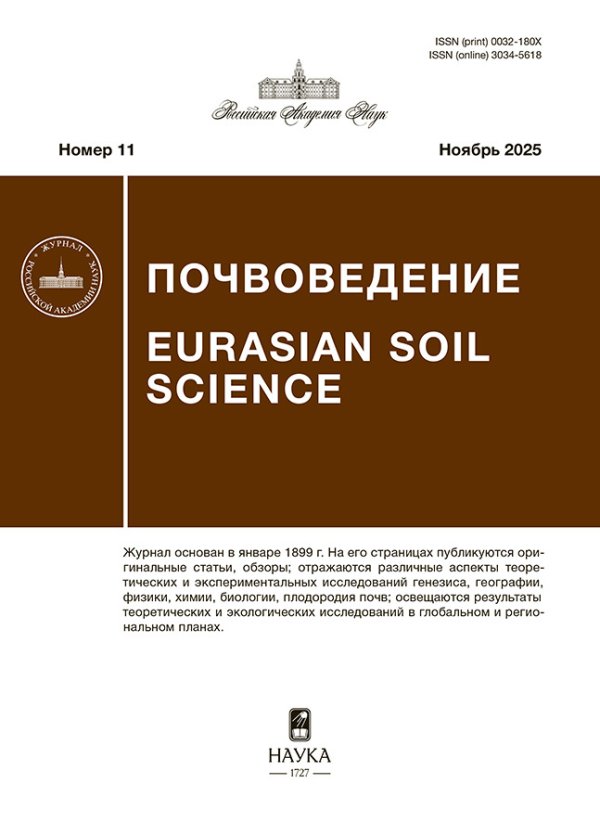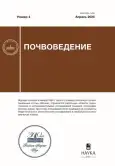Stratified Soil on Dictioneme Shales in the Area of the Last Cover Glaciation (Southern Ladoga Region): Properties, Paleogeographic Interpretation, and Radiocarbon Dating Issues
- Authors: Rusakov A.V.1,2, Sedov S.N.3,4, Savelieva L.A.1, Popov A.I.1, Zazovskaya E.P.5,6
-
Affiliations:
- St. Petersburg State University
- Institute of Physics of the Earth of the Russian Academy of Sciences
- Institute of Geology of the National Autonomous University of Mexico
- Institute of the Earth’s Cryosphere, Federal State Budgetary Institution FITZ Tyumen Scientific Center of the Siberian Branch of the Russian Academy of Sciences
- Center for Applied Isotope Research, University of Georgia
- Institute of Geography of the Russian Academy of Sciences
- Issue: No 4 (2025)
- Pages: 449-463
- Section: GENESIS AND GEOGRAPHY OF SOILS
- URL: https://modernonco.orscience.ru/0032-180X/article/view/682942
- DOI: https://doi.org/10.31857/S0032180X25040028
- EDN: https://elibrary.ru/CMHAQD
- ID: 682942
Cite item
Abstract
In the Valdai glaciation area (the valley of the Lyubsha River, Leningrad region), the morphological features at the macro, meso, and micro levels and the properties of a unique virgin dark humus dark-profile stratified clay soil formed from locally redeposited dictionemic shales (the Lyubsha section) overlain by a thin late glacial fine sand and silty loams deposited by the Aeolian way are considered and enriched with carbonate crushed stone and glauconite material. The local redeposition of dictionemic shales in the thickness of the section is confirmed by the data of spore-pollen analysis of the layers at its base (tundra vegetation), where the shale layers are underlain by Cambrian sands. The shale thickness underwent cryogenic cracking, increasing from the lower horizons of the profile to the upper ones, which was diagnosed by the micromorphological method. The soil developed under subaerial conditions starting in the Late Pleistocene. Holocene pedogenesis, along with the allochthonous stratum, covers only the upper layer of shale (AUca horizon), in which structuration, decompression, and inclusion of fragments of shale with undisturbed microstructure are noticeable. Such a low manifestation of soil formation on dictionemic shales is determined by the large “buffering” of the parent material and the predominance of a difficult-to-oxidize fraction in the organic matter of shales. The definite radiocarbon age of the organic matter of the dictionemic layers, which varies from the lower horizons to the upper ones in the range of ~36–24 cal. BP. (the Lyubsha section) and ~35–26 cal. BP. (the section on the Kirchhoff Upland), does not reflect the real age of soil formation. The organic matter of these soils is heterogeneous and heterochronous. Both the “dead” organic matter of shales and younger organic matter of pedogenic origin contribute to the radiocarbon age. This should be taken into account when 14C-dating and interpreting the results obtained.
Full Text
##article.viewOnOriginalSite##About the authors
A. V. Rusakov
St. Petersburg State University; Institute of Physics of the Earth of the Russian Academy of Sciences
Author for correspondence.
Email: spp-06@mail.ru
ORCID iD: 0000-0002-1351-9050
Russian Federation, St. Petersburg, 199034; Moscow, 123995
S. N. Sedov
Institute of Geology of the National Autonomous University of Mexico; Institute of the Earth’s Cryosphere, Federal State Budgetary Institution FITZ Tyumen Scientific Center of the Siberian Branch of the Russian Academy of Sciences
Email: spp-06@mail.ru
Mexico, Mexico City, Ciudad Universitaria, 04510; Tyumen, 625026 Russia
L. A. Savelieva
St. Petersburg State University
Email: spp-06@mail.ru
Russian Federation, St. Petersburg, 199034
A. I. Popov
St. Petersburg State University
Email: spp-06@mail.ru
Russian Federation, St. Petersburg, 199034
E. P. Zazovskaya
Center for Applied Isotope Research, University of Georgia; Institute of Geography of the Russian Academy of Sciences
Email: spp-06@mail.ru
United States, Athens, Georgia, 30602; Moscow, 119017 Russia
References
- Апарин Б.Ф., Касаткина Г.А., Матинян Н.Н., Сухачева Е.Ю. Красная книга почв Ленинградской области. СПб.: Аэроплан, 2007. 320 с.
- Аринушкина Е.В. Руководство по химическому анализу почв. М.: Изд-во Моск. ун-та, 1971. 492 с.
- Бахмет О.Н. Остров Кижи. Литогенные почвы, сформировавшиеся на шунгитовых сланцах: Путеводитель почвенной экскурсии VI съезд общества почвоведов им. В.В. Докучаева. 13–18 августа. Петрозаводск, 2012. 35 с.
- Вялов В.И, Балахонова А.С., Ларичев А.И., Богомолов А.Х. Рений в диктионемовых сланцах Прибалтийского бассейна // Вестн. Моск. ун-та. Сер. 4. Геология. 2013. № 2. С. 63–68.
- Гагарина Э.И. Литологический фактор почвообразования (на примере Северо-Запада Русской равнины). СПб.: Изд-во С.-Петерб. ун-та, 2004. 260 с.
- Гагарина Э.И., Матинян Н.Н., Счастная Л.С., Касаткина Г.А. Почвы и почвенный покров Северо- Запада России. СПб.: Изд-во СПбГУ, 1995. 234 с.
- Геоморфология и четвертичные отложения Северо-Запада Европейской части СССР / Под ред. Малаховского Д.Б., Маркова К.К. Л.: Наука, 1969. 256 с.
- Горленко В.М., Жмур С.И. Автохтонное органическое вещество в диктионемовых сланцах ордовика Прибалтики // Доклады АН СССР. 1989. Т. 309. № 1. С. 154–157.
- Горячкин С.В., Макеев А.О. Направления таежного почвообразования: спектр мезоморфных почв европейского севера // Почвообразование и выветривание в гумидных и семигумидных ландшафтах. М., 1991. С. 8–72.
- Гричук В.П., Заклинская Е.Д. Анализ ископаемых пыльцы и спор и его применение в палеогеографии / Под ред. Маркова К.К. М.: Географгиз, 1948. 223 с.
- Классификация и диагностика почв России. Смоленск: Ойкумена, 2004. 342 с.
- Красильников П.В., Седов С.Н., Гракина Е.Р. Разрушение эндогенных слоистых силикатов в почвах на элювии основных пород в Северной Карелии // Почвоведение. 1999. № 4. С. 458–475.
- Куприянова Л.А., Алешина Л.А. Пыльца двудольных растений флоры Европейской части СССР. Л.: Наука, 1978. 184 с.
- Куприянова Л.А., Алешина Л.А. Пыльца и споры растений флоры Европейской части СССР. Т. 1. Л.: Наука, 1972. 171 с.
- Лесовая С.Н., Горячкин С.В., Погожев Ю.С., Полеховский Ю.Н., Заварзин А.А., Заварзина А.Г. Химико-минералогические свойства, генезис, проблемы классификации почв на плотных породах Северо-Запада России // Почвоведение. 2008. № 4. С. 406–420.
- Лобанов И.Н. О природе дислокаций Дудергофских высот и района г. Павловска // Изв. Всесоюзн. географичес. общ-ва. 1979. Т. 111. Вып. 4. С. 334–342.
- Матинян Н.Н., Рейманн К., Бахматова К.А., Русаков А.В. Фоновое содержание тяжелых металлов и мышьяка в пахотных почвах Северо-Запада России (по материалам Международного геохимического атласа) // Вестник С.-Петерб. ун-та. 2007. Сер. 3. Вып. 3. С. 123–133.
- Попов А.И., Русаков А.В. Использование хемодеструкционного фракционирования для характеристики органического вещества почв // Нетрадиционные природные ресурсы, инновационные технологии и продукты: Сб. науч. трудов. Вып. 21. М.: РАЕН, 2013. C. 36–44.
- Путеводитель экскурсий 2-го съезда общества почвоведов России / Под ред. Апарина Б.Ф. СПб.: Изд-во С.-Петерб. ун-та, 1996. 131 с.
- Растворова О.Г. Физика почв (практическое руководство). Л.: Изд-во ЛГУ, 1983. 192 с.
- Седов С.Н., Васенева Э.Г., Шоба С.А. Современные и древние процессы выветривания в почвах на основных породах о-ва Валаам // Почвоведение. 1992. № 7. С. 83–96.
- Шекк Г.В., Градусов Б.П., Урусевская И.С. Особенности химического состава тонкодисперсного материала почв, развитых на шунгитах и шунгитсодержащих моренных отложениях Карелии // Вестн. МГУ. Сер. 17, почвоведение. 1993. № 3. С. 32–45.
- Чичагова О.А. Радиоуглеродное датирование гумуса почв. 1985. М.: Наука, 158 с.
- Чичагова О.А., Хохлова О.С., Зазовская Э.П., Горячкин С.В. Радиоуглеродный анализ и проблемы памяти почв // Память почв. Почва как память биосферно-геосферно-атропосферных взаимодействий. М., 2008. С. 182–200.
- Abakumov E.V., Koptseva E.M. Ecogenesis and primary soil formation on the East European Plain. A review // Folia Oecologia. 2022. V. 49. P. 51–60. https://doi.org/ 10.2478/foecol-2022-0006
- Agatova A.R., Nepop R.K., Bronnikova M.A., Zhdanova A.N., Moska P., Zazovskaya E.P., Khazina I.V. Problems of 14C dating in fossil soils within tectonically active highlands of Russian Altai in the chronological context of the late Pleistocene megafloods // Catena. 2020. V. 195. https://doi.org/ 10.1016/j.catena.2020.104764
- Bronk Ramsey C., Higham T., Leach P. Towards high-precision AMS; progress and limitations. Radiocarbon. 2004. V. 46. P. 17–24.
- Hedeving A., Ekström F., Johnson Mark D., Alexanderson H., Baykal Y., Stevens T. Thin loess in Southwestern Sweden // GFF. 2024. https://doi.org/ 10.1080/11035897.2024.2326208
- Moore P.D., Webb J.A., Collinson M.E. Pollen analysis. Oxford: Blackwell Scientific Publications, 1991. 216 р.
- Reimer P., Austin Wen, Bard E., Bayliss A., Blackwell P.G., Bronk Ramsey C., Butzin M. et al. The IntCal20 Northern Hemisphere radiocarbon age calibration curve (0–55 cal kBP) // Radiocarbon. 2020. V. 62. P. 725–757. https://doi.org/ 10.1017/RDC.2020.41
- Stroeven A.P., Hättestrand C., Heyman J. Deglaciation of Fennoscandia // Quater. Sci. Rev. 2016. V. 147. P. 91–121. https://doi.org/ 10.1016/J.QUASCIREV. 2015.09.016
Supplementary files













